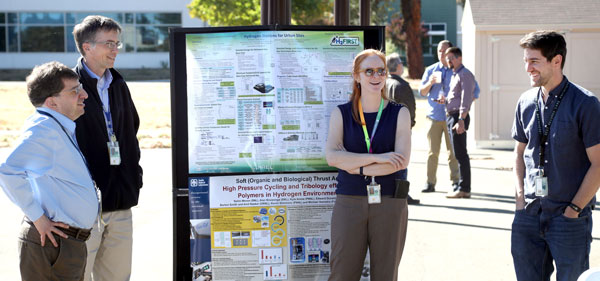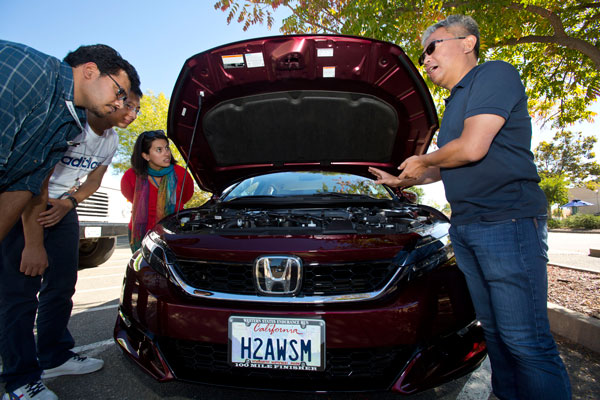Sandia celebrates National Hydrogen and Fuel Cell Day
The molecular formula for hydrogen is H2, but recently, Sandia celebrated the first element on the periodic table as No. 1 for its ability to provide a clean, efficient power source.
Sandia/California’s event was one of many across the country held to mark the fourth National Hydrogen and Fuel Cell Day, held annually on Oct. 8 as a nod to hydrogen’s atomic weight of 1.008.

The occasion offered an opportunity to highlight Sandia’s advanced research involving hydrogen fuel and to showcase the ways Sandia’s work impacts transportation energy at the national level.
Scientist Ethan Hecht presented a poster about the Labs’ partnership with the National Renewable Energy Laboratory that seeks to fit larger-capacity hydrogen fueling stations for vehicles into space-challenged urban areas such as San Francisco or New York City.
Although only 5,000 or so hydrogen fuel cell cars ply U.S. roads, hydrogen fueling stations are in short supply, and demand is increasing. To meet that demand, retailers are switching from gaseous to liquid hydrogen because liquid is denser, so they can store more of it in the same amount of space.
“One of the big roadblocks for liquid hydrogen storage is the 75-foot setback distance required by current fire codes between building openings and air intakes,” Ethan said. “If you draw a 75-foot circle around your system, it starts to be a pretty big footprint.” That’s why the H2FIRST team is doing safety modeling to figure out whether the footprints can be reduced through novel configurations of station components.

Illustrating the desirability of cars powered by fuel cells, Lawrence Livermore materials scientist Tadashi Ogitsu brought his own Honda Clarity for attendees to check out. Ogitsu has had the car for over a year, and says he loves to drive it.
“It’s very quiet. There’s no transmission, so it’s super smooth, and I can make it from Dublin, California, to Yosemite on one fill up,” Ogitsu said.
Ogitsu, who works on hydrogen production from water via advanced high and low-temperature electrolysis, says he would not hesitate to get another fuel cell car the next time he is in the market for a vehicle.
Sandia hydrogen and fuel cells program manager Jon Zimmerman called the celebration a success.
“It helped raise our coworkers’ awareness of fuel cell vehicles as an option that, in California, is here now. There are more than 35 hydrogen fueling stations throughout the state, and vehicles are available for purchase or lease from several traditional car companies,” he said. “This once-futuristic vision has become a reality, in part due to the work done at Sandia.”